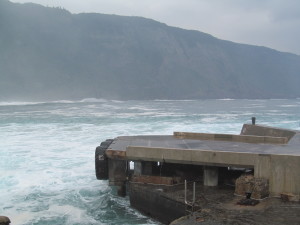Molokai, HI — Think of it as a wild roller coaster ride, except that you are on a mule. Yes my ass hurts! No, I’m not talking about the mule! It was one of those bucket list things I had to do, taking a mule ride on the world’s tallest sea cliffs to Kalaupapa National Historic Park, a tragic site where victims of leprosy or Hansen’s Disease were once forced into exile.
“That’s crazy! Why would you want to do that?” a friend asked me before the trip. “It’s the same thing that made me want to go to Indonesia to see the komodo dragons or hike the Inca trail to Machu Picchu. I have to do it, ” I declared.
The tour begins early in the morning. After some basic riding instructions, you are assigned your mule. My mule is Koa, the Hawaiian word for warrior. But Koa doesn’t always follow the instructions of our guides and likes to stop and chew at the grass and leaves. Now I’ve been called a stubborn ass more than a few times in my life, so perhaps Koa and I are the perfect match.
The path to Kalaupapa is steep and winding. Sometimes the trail gets very narrow and at times you feel like your gonna fall off the edge. It’s a 1700 foot drop. Not for those afraid of heights. “Hold on and trust the mule!” our guides yell. I grip the Koa’s saddle and reigns tightly as if my life depended on it. There are 26 switchbacks going down the trail. I feel the friction on my butt from the motion of the saddle. My finger begins to bleed from the friction of the reigns. I’m going to feel the burn later on.
My head brushes up against tree branches and spider webs. I wonder how much more I can take. The mules seem to know what they’re doing. They’ve been this way before. Six days a week, carrying travelers like me on their backs. The view of the peninsula is amazing. One of the most spectacular I have ever seen. I want to shoot photos, but it’s not so easy when you’re riding on a mule.
Finally, after an hour or so we reach our destination. For the mules it’s lunch and a much needed rest for the return journey. For those on the ride we are picked up by an old yellow school bus and taken to Kalaupapa.
For more than a century leprosy patients were forced into isolation on Kalaupapa. It is considered one of the saddest chapters in our history. Families were separated. Patients were not allowed to keep children if they had them. Patients who refused to go as they were brought over on boats were thrown into the water. In some cases, sea captains who were terrified of the disease ordered patients thrown overboard. Those who could swim, swam to shore. Those who couldn’t drowned.
Father Damien, a Belgian priest arrived in 1873. He was the first missionary to offer assistance and hope to the patients. Damien eventually succumbed to the disease. A year before Damien died, Sister Marianne Cope, a German nun arrived to care for Damien and other patients. She established a girls home on the settlement and encouraged patients to live life to their fullest. Sister Cope stayed for 30 years until her death from natural causes in 1918. Both Father Damien and Sister Cope are recognized as saints by the Catholic Church. They are America’s first saints.
In the 1940’s antibiotics were developed to treat and control leprosy, but the isolation policies did not end until 1969. Around 8,000 patients were sent to Kalaupapa during it’s hundred plus year history. A few remain today, ranging from theirs 70’s to 90’s. They stay because this is the only home they’ve ever known. In 1980 Kalaupapa became a national park, dedicated to preserving memories and lessons of the past.
After the tour we begin our way back. I mount Koa. The ride up seems easier. “Lean forward as you go up. Lean back as you go down, ” the guides instruct us. The mules are strong. They make their way up the trail, occasionally stopping for a short break. We complete our journey in less time than it took us to go down. I am tired, sore , a bit wobbly in the knees, but today I feel as if I accomplished something.
Audrey, one of our guides rides next to me, “You’re on the highest sea cliffs in the world, riding a mule and you learned some history today. You’re living a dream! “she exclaims.














Marilyn Tokuda
January 19, 2016 | 8:26 pm
Nice commentary, Mark. Hope your okole feels better!
Have a great rest of trip; we can’t wait to hear about your adventures!
Marilyn